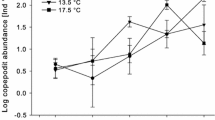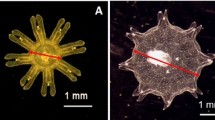Abstract
Length growth, instar durations, fecundity and mortality rates of fivespecies of microcrustacean zooplankton from a tropical reservoir weremeasured in relation to food quantity and temperature in laboratorycultures. Three cladocerans (Ceriodaphnia cornuta, Moina micrura,Diaphanosoma excisum), one calanoid copepod (Heliodiaptomus viduus), and onecyclopoid copepod (Mesocyclops thermocyclopoides) were studied. Filteredseston (45 µm mesh) from a local pond was used for food. Two foodconcentrations were employed: (1) 10 µg chlorophyll l−1(ca 0.25 mg Cl−1), and (2) 50 µg chlorophylll−1 (ca 1.25 mg C l−1). Food levels and watertemperature (22.5, 27.5, and 32.5 °C) used, roughly covered the rangesfound in the reservoir. Although all the three growth parameters were oftenaffected to some degree by temperature and food, the quantitative responseof the species differed. Also, the species reacted differently to the threepossible interactions (i.e. food × temperature,food × instar, andtemperature × instar). This contributed to the overalldifferences in the species responses. For the cladocerans, instar durationswere always affected by temperature. The food did not affect the durationtime of the adults and that of the combined juvenile instars, the latterexcept in one case significantly. For the two copepods food level affectedthe duration times of naupliar and copepodite instars, but the effect oftemperature was only significant for H. viduus. The development timesobserved for H. viduus were extraordinary long compared with values reportedin the literature for other tropical calanoids. This suggests that foodconditions in our culture were adversely affecting its growth rates.
Similar content being viewed by others
References
Abraham, S. & U.K. Gopalan, 1975. Growth of an estuarine harpacticoid copepod Nitocra spinipesBoeck cultured in the laboratory. Bull. Dept. mar. Sci. Univ. Cochin 7: 309–318.
Anderson, D. H. & A. C. Benke, 1994. Growth and reproduction of the cladoceran Ceriodaphnia dubiafrom a forested floodplain swamp. Limnol. Oceanogr. 39: 1517–1527.
Bailey-Watts, A. E., 1974. The algal plankton of Loch Leven, Kinross. Proc. r. Soc. Edinb. (B) 74: 135–156.
Bonou, C. A., M. Pagano & L. Saint-Jean, 1991. Développement et croissance en poids de Moina(cf) micruraet de Mesocyclops ogunnusdans unmilieu saumtre tropical: les tangs de pisciculture de Layo (Cte-d’Ivoire). Revue Hydrobiol. trop. 24: 287–303.
Bowen, S. H., 1988. Detritivory and herbivory. In Leveque, C., M. N. Bruton & G. W. Ssentongo (eds), Biology and Ecology of African Freshwater Fishes. ORSTROM, Paris: 243–247.
Burgis, M. J., 1971. The ecology and production of copepods, particularly Thermocyclops hyalinus, in the tropical Lake George, Uganda. Freshwat. Biol. 1: 169–192.
Dumont, H. J. & J. G. Tundisi (eds), 1984. Tropical Zooplankton. Developments in Hydrobiology 23. Dr W. Junk Publishers, The Hague, 355 pp. Reprinted from Hydrobiologia 113.
Duncan, A., 1989. Food limitation and body size in the life cycles of planktonic rotifers and cladocerans. Hydrobiologia 186/187: 11–28.
Fahrenbach, W. H., 1962. The biology of a harpacticoid copepod. Cellule 62: 303–376.
Fernando, C. H., 1994. Zooplankton, fish and fisheries in tropical freshwaters. Hydrobiologia 272: 105–123.
Fernando, C. H. & J. Holcik, 1982. The nature of fish: A factor influencing the fishery potential and yields of tropical lakes and reservoirs. Hydrobiologia 97: 127–140.
Gliwicz, Z. M. & W. Lampert, 1990. Food thresholds in Daphnia species in the absence and presence of blue-green filaments. Ecology 71: 691–702.
Gophen, M., 1976. Temperature effect on lifespan, metabolism and development time of Mesocyclops leuckarti(Claus). Oecologia 25: 271–277.
Goulden, C. E., L. Hornig & C. Wilson, 1978. Why do large zooplankton species dominate?. Verh. int. Ver. Limnol. 20: 2457–2460.
Gras, R. & L. Saint-Jean, 1976. Dure et charactéristiques du développement embryonnaire chez quelques espèces de cladoceres et de copepodes du Lac Tchad. Cah. ORSTOM sr. Hydrobiol. 10: 233–254.
Gras, R. & L. Saint-Jean, 1978. Dure et charactéristiques du développement juvenile de quelques cladocères du Lac Tchad. Cah. ORSTOM sr. Hydrobiol. 12: 119–136.
Gras, R. & L. Saint-Jean, 1981. Dure du développement juvenile de quelques Copepodes planctoniques du Lac Tchad. Revue Hydrobiol. trop. 14: 39–51.
Hanna, N. S. & F. Schiemer, 1993. The seasonality of zooplanktivorous fish in an African reservoir (Gebel-Aulia reservoir, White Nile, Sudan). 2. Spatial distribution and resource partitioning in zooplanktivorous fish assemblages. Hydrobiologia 250: 187–199.
Hardy, E. R. & A. Duncan, 1994. Food concentration and temperature effects on life cycle characteristics of tropical Cladocera (Daphnia gessneriHerbst, Diaphanosoma sarsiRichard, Moina reticulata(Daday)): I. Development time. Acta Amazonica 24: 119–134.
Hart, R. C., 1985. Embryonic development times of entomostracan zooplankton from Lake Le Roux (Orange River, South Africa), and their possible relationship to seasonal succession. Hydrobiologia 127: 17–26.
Hebert, P. D. N., 1978. The population biology of Daphnia(Crustacea, Daphnidae). Biol. Rev. 53: 387–426.
Hecky, R. E., 1991. The pelagic ecosystem. In Coulter, C. W. (ed.), Lake Tanganyika and its Life. Oxford University Press, Oxford: 90–110.
Hicks, G. R. F. & B. C. Coull, 1983. The ecology ofmarine meiobenthic harpacticoid copepods. Oceanogr. Mar. Biol. Ann. Rev. 21: 67–175.
Jana, B. B. & G. P. Pal, 1984. The life history parameters of Diaphanosoma excisum(Cladocera), grown in different culturing media. Hydrobiologia 118: 205–212.
Lampert, W., 1977. Studies of the carbon balance of Daphnia pulex de Geer as related to environmental conditions. IV. Arch. Hydrobiol. Suppl. 48: 361–368.
Lynch, M. & J. Shapiro, 1981. Predation, enrichment and phytoplankton community structure. Limnol. Oceanogr. 26: 86–102.
Marshall, B. E., 1984. Small pelagic fishes and fisheries in African inland waters. FAO, CIFA Tech. Pap. 14, 25 pp.
Mavuti, K. M., 1994. Durations of development and production estimates by two crustacean zooplankton species Thermocyclops oblongatusSars (Copepoda) and Diaphanosoma excisumSars (Cladocera), in Lake Naivasha, Kenya.Hydrobiologia 272: 185–200.
Meyer, J. S., C. G. Ingersoll, L. L. McDonald & M. S. Boyce, 1986. Estimating uncertainty in population growth rates: Jackknife vs Bootstrap techniques. Ecology 67: 1156–1166.
Mills, E. L., J. L. Forney & K. J. Wagner, 1987. Fish predation and its cascading effect on the Oneida Lake food chain. In Kerfoot, W. C. & A. Sih (eds), Predation. Direct and Indirect Impact on Aquatic Communities. University Press of New England. Hannover, London: 118–131.
Montu, M., 1973a. Cremiento y desarrollo en algunas especies de cladoceros dulceacuicolas. IV. Ceriodaphnia cornutaSars, 1886. Physis (B) 32: 215–222.
Montu, M., 1973b. Crecimiento y desarrollo en algunas especies de cladoceros dulceacuicolas. II. Moina reticulata(Daday, 1905). Physis (B) 32: 207–214.
Montu, M., 1973c. Crecimiento y desarrollo en algunas especies de cladoceros dulceacuicolas. II. Moina micruraKurz, 1874. Physis (B) 32: 93–104.
Murugan, N., 1975. Egg production, development and growth in Moina micruraKurz (1874) (Cladocera: Moinidae). Freshwat. Biol. 5: 245–250.
Newrkla, P. & A. Duncan, 1984. The biology and density of Ehirava fluviatilis(Clupeoid) in Parakrama Samudra, Sri Lanka. Verh. int. Ver. Limnol. 22: 1572–1578.
Pace, M. L., K. G. Porter & Y. S. Feig, 1983. Species-and agespecific differences in bacterial resource utilization by two cooccurring cladocerans. Ecology64: 1145–1156.
Persson, G., 1985. Community grazing and the regulation of in situ clearance and feeding rates of planktonic crustaceans in lakes in the Kuokkel area, northern Sweden. Arch. Hydrobiol. 70: 197–238.
Piet, G. J., J. Vijverberg & W. L. T. van Densen, in press. Foodweb structure of a Sri Lankan reservoir. In van Densen, W. L. T. & R. H. Low-McConnel (eds), Lacustrine Fish Communities in S.E. Asia and Africa. Ecology and Exploitation. Samarar Publishing Limited, Tresaith, UK.
Piyasiri, S., 1985. Dependence of food on growth and development of two freshwater tropical and temperate calanoid species. Verh. int. Ver. Limnol. 22: 3185–3189.
Shapiro, J. & D. I. Wright, 1984. Lake restoration by biomanipulation: Round Lake, Minnesota, the first two years. Freshwat. Biol. 14: 371–383.
Sirimongkonthaworn, R. & C. H. Fernando, 1994. Biology of Clupeichthys aesarnensis(Clupeidae) in Ubolratana reservoir, Thailand, with special reference to food and feeding habits. Int. Revue ges. Hydrobiol. 79: 95–112.
Vareschi, E., & J. Jacobs, 1984. The ecology of lake Nakuru (Kenya). V. Production and consumption of consurner organisms. Oecologia 61: 83–98.
Vijverberg, J., 1977. Population structure, life histories and abundance of copepods in Tjeukemeer, The Netherlands. Freshwat. Biol. 7: 579–597.
Vijverberg, J., 1989. Culture techniques for studies on the growth, development and reproduction of copepods and cladocerans under laboratory and in situ conditions: a review. Freshwat. Biol. 21: 317–373.
Vijverberg, J., M. Boersma, W. L. T. van Densen, W. Hoogenboezem, E. H. H. R. Lammens & W. M. Mooij, 1990. Seasonal variation in the interactions between piscivorous fish, planktivorous fish and zooplankton in a shallow eutrophic lake. Hydrobiologia 207: 279–286.
Witte, F., T. Goldschmidt, P. C. Goudswaard, W. Ligtvoet, M. J. P. Vanoijen & J. H. Wanink, 1992. Species extinction and concomitant ecological changes in Lake Victoria. Neth. J. Zool. 42: 214–232.
Author information
Authors and Affiliations
Rights and permissions
About this article
Cite this article
Amarasinghe, P.B., Boersma, M. & Vijverberg, J. The effect of temperature, and food quantity and quality on the growth and development rates in laboratory-cultured copepods and cladocerans from a Sri Lankan reservoir. Hydrobiologia 350, 131–144 (1997). https://doi.org/10.1023/A:1003087815861
Issue Date:
DOI: https://doi.org/10.1023/A:1003087815861




